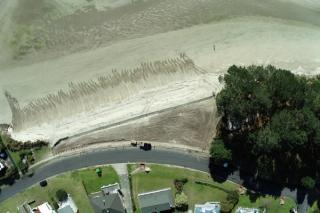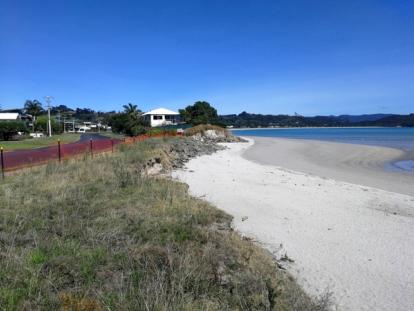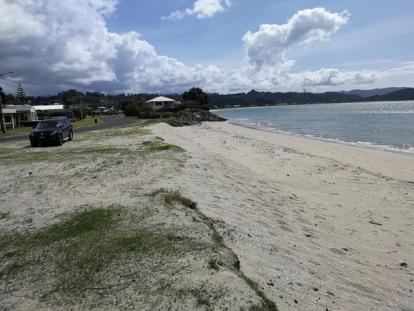Cooks Beach Coastal Management Regime
- Client Name
- Thames Coromandel District Council
- Location
- Coromandel Peninsula, New Zealand
- Ecology
- Planning
- Climate resilience planning & design

Challenge
The eastern end of Cooks Beach on the Coromandel Peninsula of New Zealand has been subject to considerable erosion pressure over recent years, which has, in part, been attributed to the installation of a large seawall.
To address the coastal erosion issues, Thames Coromandel District Council (TCDC) engaged the Coastal team to develop options to protect the adjacent public reserve and roading infrastructure against future significant weather events that would cause further erosion.
Due to the impacts of sea levels rising and climate change being realised, coastal management solutions are now shifting away from traditional protection structures to more natural management regimes that include beach nourishment, dune planting, and softer hybrid protection measures. Implementing a management plan that could incorporate this more holistic approach was the ultimate goal of the clients.
Solution
The Coastal team led the coastal processes and ecological investigations, concept design, and the resource consenting process for a backstop wall and dune restoration management plan at Cooks Beach, which would achieve the client's desired outcome of a hybrid coastal protection solution that incorporated natural processes.
The work involved included analysing aerial photo records and beach monitoring data to determine the extent and underlying causes of the erosion issues. These investigations were then ground-truthed, and sensitive ecological areas were highlighted to refine the potential borrow areas for the nourishment plan. Concept designs for a nourishment regime were devised, supported by a buried backstop seawall positioned to protect key infrastructure. It is anticipated that the structure will remain buried under most conditions, allowing for a stabilised sand wall to be used due to the limited exposure that is expected. This option was also preferred due to the aesthetic values once the wall becomes exposed, and the cost saving associated with utilising local material.
The intention behind the response was to have a structure that could cope with extreme events and periods of low sand volumes. The sand placed in front of the structure would then serve to provide a protective buffer, visual and recreational amenity and aid in the restoration of a dune system. It is expected that the nourished sand would eventually be taken away by storms and tide. This has in part, been allowed for by planting dune building species above the crest of the buried wall that with time will begin to help the retention of the nourished sand at this location. But this will require regular maintenance work to ensure the project's success.
As with any coastal system on the New Zealand coast, there was also a lot of uncertainty about how the beach would respond to moving sand around the system. To address this uncertainty, the team developed a detailed adaptive monitoring and management plan that identifies and addresses any potential adverse effects on the receiving environment. In particular, this is related to future nourishment works and sources of sand for these activities.
Before and After
Impact
It was highlighted and accepted by TCDC that during periods of storminess the wall would become exposed, and that maintenance would be required.
But the structure has been well tested recently during Cyclone’s Hale and Gabrielle, and when the wall becomes exposed, it visually complements the surrounding beach and landscape while still providing an important backstop for the surrounding area and local community when the beach disappears.

